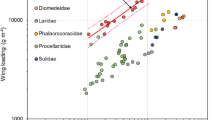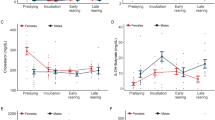Abstract
Breeding animals trade off maximizing energy output to increase their number of offspring with conserving energy to ensure their own survival, leading to an energetic ceiling influenced by external, environmental factors or by internal, physiological factors. We examined whether internal or external factors limited energy expenditure by supplementally feeding breeding black-legged kittiwakes varying in individual quality, based on earlier work that defined late breeders as low-quality and early breeders as high-quality individuals. We tested whether energy expenditure increased when food availability decreased in both low- and high-quality birds; we predicted this would only occur in high-quality individuals capable of sustaining high levels of energy expenditure. Here, we find that food-supplemented birds expended less energy than control birds because they spent more time at the colony. However, foraging trips of food-supplemented birds were only slightly shorter than control birds, implying that food-supplemented birds were limited by food availability at sea similarly to control birds. Late breeders expended less energy, suggesting that low-quality individuals may not intake the energy necessary for sustaining high-energy output. Food-supplemented birds had more offspring than control birds, but offspring number did not influence energy expenditure, supporting the idea that the birds reached an energy ceiling. Males and lighter birds expended more energy, possibly compensating for relatively higher energy intake. Chick-rearing birds were working near their maximum, with highest levels of expenditure for early-laying (high-quality) individuals foraging at sea. Due to fluctuating marine environments, kittiwakes may be forced to change their foraging behaviors to maintain the balance between reproduction and survival.





Similar content being viewed by others
Availability of data and code
Data and statistical code were uploaded as supplementary materials for review during the initial submission. If accepted, these will be published as supplementary materials.
References
Ainley DG, Ford RG, Brown ED et al (2003) Prey Resources, competition, and geographic structure of kittiwake colonies in Prince William sound. Ecology 84:709–723. https://doi.org/10.1890/0012-9658(2003)084[0709:PRCAGS]2.0.CO;2
Bates D, Mächler M, Bolker B, Walker S (2015) Fitting linear mixed-effects models using lme4. J Stat Softw 67:1–48. https://doi.org/10.18637/jss.v067.i01
Bautista LM, Tinbergen J, Wiersma P, Kacelnik A (1998) Optimal foraging and beyond: how starlings cope with changes in food availability. Am Nat 152:543–561. https://doi.org/10.1086/286189
Birt-Friesen VL, Montevecchi WA, Cairns DK, Macko SA (1989) Activity-specific metabolic rates of free-living northern gannets and other seabirds. Ecology 70:357–367. https://doi.org/10.2307/1937540
Briga M, Verhulst S (2017) Individual variation in metabolic reaction norms over ambient temperature causes low correlation between basal and standard metabolic rate. J Exp Biol 220:3280–3289. https://doi.org/10.1242/jeb.160069
Brooks ME, Kristensen K, van Benthem KJ et al (2017) glmmTMB balances speed and flexibility among packages for zero-inflated generalized linear mixed modeling. R J 9:378–400. https://doi.org/10.32614/RJ-2017-066
Chivers LS, Lundy MG, Colhoun K et al (2012) Foraging trip time-activity budgets and reproductive success in the black-legged kittiwake. Mar Ecol-Prog Ser 456:269–277. https://doi.org/10.3354/meps09691
Collins PM, Green JA, Elliott KH et al (2020) Coping with the commute: behavioural responses to wind conditions in a foraging seabird. J Avian Biol 51:e02057. https://doi.org/10.1111/jav.02057
Coulson JC, Thomas CS (1985) Changes in the biology of the kittiwake Rissa tridactyla: a 31-year study of a breeding colony. J Anim Ecol 54:9–26. https://doi.org/10.2307/4617
Coulson JC, White E (1959) The Post-fledging mortality of the kittiwake. Bird Study 6:97–102. https://doi.org/10.1080/00063655909475939
Daunt F, Benvenuti S, Harris MP et al (2002) Foraging strategies of the black-legged kittiwake Rissa tridactyla at a North Sea colony: evidence for a maximum foraging range. Mar Ecol Prog Ser 245:239–247. https://doi.org/10.3354/meps245239
Dunn RE, Wanless S, Daunt F et al (2020) A year in the life of a North Atlantic seabird: behavioural and energetic adjustments during the annual cycle. Sci Rep 10:5993. https://doi.org/10.1038/s41598-020-62842-x
Elliott KH, Chivers LS, Bessey L et al (2014a) Windscapes shape seabird instantaneous energy costs but adult behavior buffers impact on offspring. Mov Ecol 2:17. https://doi.org/10.1186/s40462-014-0017-2
Elliott KH, Le Vaillant M, Kato A et al (2014b) Age-related variation in energy expenditure in a long-lived bird within the envelope of an energy ceiling. J Anim Ecol 83:136–146. https://doi.org/10.1111/1365-2656.12126
Elliott KH, O’Reilly KM, Hatch SA et al (2014c) The prudent parent meets old age: A high stress response in very old seabirds supports the terminal restraint hypothesis. Horm Behav 66:828–837. https://doi.org/10.1016/j.yhbeh.2014.11.001
Gill VA, Hatch SA (2002) Components of productivity in black-legged kittiwakes Rissa tridactyla: response to supplemental feeding. J Avian Biol 33:113–126. https://doi.org/10.1034/j.1600-048X.2002.330201.x
Gill VA, Hatch SA, Lanctot RB (2002) Sensitivity of breeding parameters to food supply in Black-legged Kittiwakes Rissa tridactyla. Ibis 144:268–283. https://doi.org/10.1046/j.1474-919X.2002.00043.x
Golet GH, Schmutz JA, Irons DB, Estes JA (2004) Determinants of reproductive costs in the long-lived Black-legged Kittiwake: a multiyear experiment. Ecol Monogr 74:353–372. https://doi.org/10.1890/02-4029
Goutte A, Angelier F, Bech C et al (2014) Annual variation in the timing of breeding, pre-breeding foraging areas and corticosterone levels in an Arctic population of black-legged kittiwakes. Mar Ecol Prog Ser 496:233–247. https://doi.org/10.3354/meps10650
Gremillet D (1997) Catch per unit effort, foraging efficiency, and parental investment in breeding great cormorants (Phalacrocorax carbo carbo). ICES J Mar Sci 54:635–644. https://doi.org/10.1006/jmsc.1997.0250
Halsey LG (2018) Keeping slim when food is abundant: what energy mechanisms could be at play? Trends Ecol Evol 33:745–753. https://doi.org/10.1016/j.tree.2018.08.004
Hatch SA (2013) Kittiwake diets and chick production signal a 2008 regime shift in the Northeast Pacific. Mar Ecol-Prog Ser 477:271. https://doi.org/10.3354/meps10161
Jodice PGR, Lanctot RB, Gill VA et al (2000) Sexing adult black-legged kittiwakes by DNA, behavior, and morphology. Waterbirds 23:405–415. https://doi.org/10.2307/1522177
Jodice PGR, Roby DD, Hatch SA et al (2002) Does food availability affect energy expenditure rates of nesting seabirds? A supplemental-feeding experiment with Black-legged Kittiwakes (Rissa tridactyla). Can J Zool 80:214–222. https://doi.org/10.1139/Z01-221
Jodice PGR, Roby DD, Suryan RM et al (2003) Variation in energy expenditure among black-legged kittiwakes: effects of activity-specific metabolic rates and activity budgets. Physiol Biochem Zool 76:375–388. https://doi.org/10.1086/375431
Kuznetsova A, Brockhoff PB, Christensen RHB (2017) lmerTest Package: Tests in Linear Mixed Effects Models. J Stat Softw 82:1–26. https://doi.org/10.18637/jss.v082.i13
Lalla KM, Whelan S, Brown K et al (2020) Accelerometry predicts muscle ultrastructure and flight capabilities in a wild bird. J Exp Biol 223:jeb234104. https://doi.org/10.1242/jeb.234104
Laskowski KL, Moiron M, Niemela PT (2021) Integrating behavior in life-history theory: allocation versus acquisition? Trends Ecol Evol 36:132–138. https://doi.org/10.1016/j.tree.2020.10.017
McAdam AG, Boutin S (2003) Effects of food abundance on genetic and maternal variation in the growth rate of juvenile red squirrels. J Evol Biol 16:1249–1256. https://doi.org/10.1046/j.1420-9101.2003.00630.x
Osborne OE, O’Hara PD, Whelan S et al (2020) Breeding seabirds increase foraging range in response to an extreme marine heatwave. Mar Ecol-Prog Ser 646:161–173. https://doi.org/10.3354/meps13392
Patterson A, Gilchrist HG, Chivers L et al (2019) A comparison of techniques for classifying behavior from accelerometers for two species of seabird. Ecol Evol 9:3030–3045. https://doi.org/10.1002/ece3.4740
Perrins CM (1970) The timing of birds‘ breeding seasons. Ibis 112:242–255. https://doi.org/10.1111/j.1474-919X.1970.tb00096.x
Piatt JF, Parrish JK, Renner HM et al (2020) Extreme mortality and reproductive failure of common murres resulting from the northeast Pacific marine heatwave of 2014–2016. PLoS ONE 15:e0226087. https://doi.org/10.1371/journal.pone.0226087
Portugal SJ, Green JA, Halsey LG et al (2016) Associations between resting, activity, and daily metabolic rate in free-living endotherms: no universal rule in birds and mammals. Physiol Biochem Zool 89:251–261. https://doi.org/10.1086/686322
Stearns S (1992) The evolution of life histories. Oxford University Press, Oxford
Torres LG, Orben RA, Tolkova I, Thompson DR (2017) Classification of Animal Movement Behavior through Residence in Space and Time. PLoS ONE 12:e0168513. https://doi.org/10.1371/journal.pone.0168513
Trayhurn P, Douglas JB, McGuckin MM (1982) Brown adipose tissue thermogenesis is “suppressed” during lactation in mice. Nature 298:59–60. https://doi.org/10.1038/298059a0
Verhulst S, Nilsson J-A (2008) The timing of birds’ breeding seasons: a review of experiments that manipulated timing of breeding. Philos Trans R Soc B-Biol Sci 363:399–410. https://doi.org/10.1098/rstb.2007.2146
Wanless S, Frederiksen M, Daunt F et al (2007) Black-legged kittiwakes as indicators of environmental change in the North Sea: evidence from long-term studies. Prog Oceanogr 72:30–38. https://doi.org/10.1016/j.pocean.2006.07.007
Welcker J, Harding AMA, Kitaysky AS et al (2009) Daily energy expenditure increases in response to low nutritional stress in an Arctic-breeding seabird with no effect on mortality. Funct Ecol 23:1081–1090. https://doi.org/10.1111/j.1365-2435.2009.01585.x
Welcker J, Speakman JR, Elliott KH et al (2015) Resting and daily energy expenditures during reproduction are adjusted in opposite directions in free-living birds. Funct Ecol 29:250–258. https://doi.org/10.1111/1365-2435.12321
Whelan S, Hatch SA, Irons DB et al (2020) Increased summer food supply decreases non-breeding movement in black-legged kittiwakes. Biol Lett 16:20190725. https://doi.org/10.1098/rsbl.2019.0725
Wilson AJ, Nussey DH (2010) What is individual quality? An evolutionary perspective. Trends Ecol Evol 25:207–214. https://doi.org/10.1016/j.tree.2009.10.002
Acknowledgements
We would like to acknowledge the following individuals for their assistance with feeding and monitoring kittiwakes during this study: Elsa Kern-Lovick, Joshua Cunningham, Mason Stothart, Angelika Aleksandrova Aleksieva, Brianna Williams, Anne Mouillier, Kristen Lalla, Sydney Collins, Alyssa Piauwasdy, Luis Ramos, Alice Sun, and Hannes Schraft. All methods were approved by the necessary academic institutions and research was permitted by the United States Fish and Wildlife Service and Alaska Department of Fish and Game.
Funding
This work was funded by the Natural Science Engineering Research Council (NSERC) and Northern Scientific Training Program (NSTP).
Author information
Authors and Affiliations
Contributions
SRK-R, SW, JA, SAH, KHE, and SJ conceived and designed the experiments. SRK-R, SW, and JA conceived and developed the methodology. The formal analysis was conducted by SRK-R, SW, and JA while SRK-R, SW, SAH, and KHE curated the data. The investigation was conducted by SRK-R and SW. The funding acquisition was done by SRK-R, SAH, KHE, and SJ. The original draft was written by SRK-R, SW, and JA while all authors contributed to reviewing and editing the manuscript. The resources for this study were provided by SAH, KHE, and SJ. Lastly, KHE and SJ provided supervision.
Corresponding author
Ethics declarations
Conflict of interest
The authors declare that they have no known competing financial interests or personal relationships that could have appeared to influence the work reported in this paper.
Ethics approval
All experiments were conducted in adherence with animal care protocols from the institutional affiliates in this study: University of Guelph (University of Guelph Animal Care Committee #3317) and McGill University (Animal Use Protocol #7599).
Consent to participate
Not applicable.
Consent for publication
Not applicable.
Additional information
Communicated by Thomas Koert Lameris.
Supplementary Information
Below is the link to the electronic supplementary material.
Rights and permissions
About this article
Cite this article
Kahane-Rapport, S.R., Whelan, S., Ammendolia, J. et al. Food supply and individual quality influence seabird energy expenditure and reproductive success. Oecologia 199, 367–376 (2022). https://doi.org/10.1007/s00442-022-05191-y
Received:
Accepted:
Published:
Issue Date:
DOI: https://doi.org/10.1007/s00442-022-05191-y




